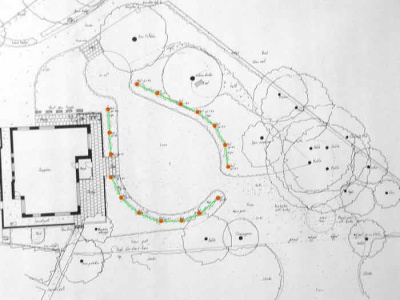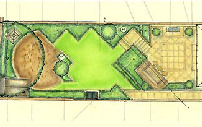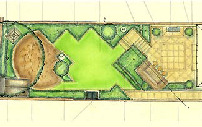UK Garden Designer
Description
Your first step towards getting the garden of your dreams.
Professional help for those seeking a glorious garden.
Hugh O’CONNELL, The Annexe, Ponchydown Farm, Blackborough,
CULLOMPTON, Devon, EX15 2HQ, UK
Email: [email protected]
Telephone: +44 (0) 1884 266188
Fax: +44 (0) 1884 266188
Planting Design
Choosing the right plants for the situation
Ashley Combe – An example of how detailed planting design can make a great difference
This follows the progress of Ashley Combe, a planting scheme described in an article first published in Devon Life
This article by Hugh O’Connell appeared in Devon homes & gardens, October 2002 p81 published by Devon Life.
The patio at Ashley Combe, Tiverton, Devon
The design principles involved in building a patio in a garden shared by two separate bungalows.
Ashley Combe Just After Planting
About 50 years ago, two bungalows were built on the Tiverton outskirts. The main one was Ashley Gables, with a "granny bungalow", Ashley Combe, accessed via the drive and paths of Ashley Gables. St Bridget Nurseries was commissioned to design the garden ‘common to both and individual to each’. The design allowed for a passage where the existing patio is located in the new design. Over the years, extensions were added to Ashley Gables, but not to Ashley Combe, and at some point Ashley Combe was given its own access, rendering the old one redundant, and this is where the patio has been constructed. Both existing owners still wish to share the gardens, but also to update and adjust, taking into account the differential in the bungalow-building development.
Plan showing the location of posts and ropes
This has been overcome by the use of vertical posts 2.13m high, set 3m apart, with thick rope in between, designed in two circular linking areas, the verticals of the posts balancing the verticals of the adjacent extended bungalow buildings. In normal walking and standing posture, vision is diffused above the head, thus the higher verticals of the extended bungalow tend to disappear above a certain height, allowing the post verticals and cross ropes to form a balance with the neighbouring bungalow. When Ashley Combe’s new drive was made, access steps off the drive and up to the bungalow did not exist, so steps 2m wide were centred off the lawn to the front door adjacent on a higher level to the patio, thus further separating the patio into a relaxing seating area.
Use of ropes to diffuse distant views
The posts and rope, when planted with clematis, roses, summer jasmine and honeysuckle, with shrubs underneath, will balance the verticals of the bungalow walls and soften the patio area, but will be light enough to allow sun into the patio area, whilst enhancing and framing the garden views. Scents from the roses and other plants immediately adjacent enhance the whole area.
When the garden has filled out with new planting by the patio development and additions throughout the rest of the garden. The garden will be open to the public for one day as part of the National Gardens Scheme on Sunday, 24th April 2005.
Planting with colour blocks for structured informality
The planting composition for the Ashley Combe Rope Garden is based on a theme created with blocks of silver plants. The beds are divided into a patchwork of planting blocks, some with a shallow timber frame to keep the plants in bounds – each one metre square, set approximately a metre apart and with one variety of plant in each block. These blocks run the length of the borders, with the blocks either centred or staggered. The blocks each contain either silver leafed plants or one plant species, and all the species are repeated throughout the scheme.
Summer 2004
The plants between the silver blocks achieve informality through the use of differing but sympathetic leaf colour, size and shape. Each block is thus the “keyâ€ý for its surrounding planting. The plant contents of the blocks differ in variety but plant group size is similar, in groups numbering up to 16 plants. The plant leaf colours between the blocks vary between shades of gold, purple, silver, grey green, light green, mid green, and dark green. The immediate leaf shapes and colour are those plants matched closest to the block plants, for example silver and gold leaves. Colour matching between the ‘blocks’ and informal plants allows the flexibility for the darker greens and contrasting colours to be placed further away from the silver “keyâ€ý blocks on the ground plane.
Above the ground plane, vertical posts connected with thick rope visually relate to the surrounding trees and buildings, and provide another level of foliage and flower above the beds. On this upper plane the dark green leaves of roses and clematis, and grey green leaves of Jasminum stephanese link together, running over the top of the silver “keyâ€ý blocks and plants below.
In late autumn/fall, the silver blocks of plants shimmer and resonate with the golden leaves of the surrounding deciduous tree and shrubs. Interest can be prolonged well into the late autumn with the secondary large white flowers of Clematis ‘Marie Boisselot’ picking up the lightness of the silver leafed plants.
Autumn 2003
The idea is to create a controlled mix of formal and informal planting. In this instance the key blocks are silver, but they could be gold or any other single colour. The block “keysâ€ý of one colour with intimately related plants can progress and change to other colour block “keysâ€ý with other related plants as one progresses through the garden, keeping within an overall composition of differing vertical planes, for example trees, or as in this garden, wooden posts.
By following the planting plan and themes, and noting the compositional changes of leaf colour, shape and size, the client was able to substitute some of her own plants in some places.
Some of the plants used on the plan
Silver blocks: Stachys ‘Silver Carpet’, Senecio, ‘Sunshine’ (Brachyglottis ‘Sunshine’), Santolina chamaecyparissus.
Gold leaves between blocks: Aucuba ‘Gold Strike’, Choisya ‘Sundance’, Euonymus ‘Emerald and Gold’, Lysimachia nummularia, Spiraea ‘Gold Flame’.
Grey/Silver leaves between blocks: Artemisia ‘Lambrook Silver’, Iris ‘Frost & Flame’, Iris ‘Party Dress’, Iris ‘Berkeley Gold’. Indigofera heterantha, ‘Lavandula Hidcote’, Lavandula angustifolia, Perovskia atriplicifolia ‘Blue Spire’.
Light/mid green leaves: Alchemilla mollis, Cimicifuga americana, Diascia ‘Ruby Field’, Hebe rakaiensis, Hemerocallis in variety, Monarda ‘Cambridge Scarlet’, Sisyrinchium striatum, Scabiosa ‘Clive Greaves’.
Climbers: Clematis ‘Duchess of Edinburgh’, Clematis ‘Marie Boissebt’, Jasminium stephanense, Rosa ‘Iceberg Climber’.
The client’s plants
Silver blocks: Artemisia ‘Powis Castle’, Cotula hispida, Carex ‘Blue Glow’, Santolina chamaecyparissus nana Santolina chamaecyparissus ‘Lambrook Silver’, Santolina pinnata ‘Edward Bowles’.
Gold leaves between blocks: Carex elata ‘Aurea’, Caryopteris x ‘Worcester Gold’, Deschampsia ‘Tetra Gold’, Hakonechloa macra ‘Aureola’, Patrinia triloba.
Dark green and bronze leaves between blocks: Eupatorium rugosum, Heuchera ‘Palace Purple’, and varieties, Lobelia cardinalis ‘Queen Victoria’, Foeniculum vulgare ‘Purpureum’, Sedum ‘Vera Jameson’, Uncinia rubra — would make a good block plant.




